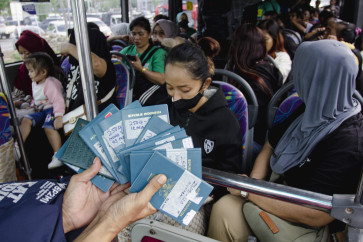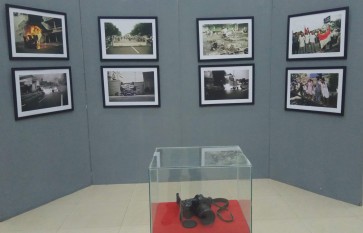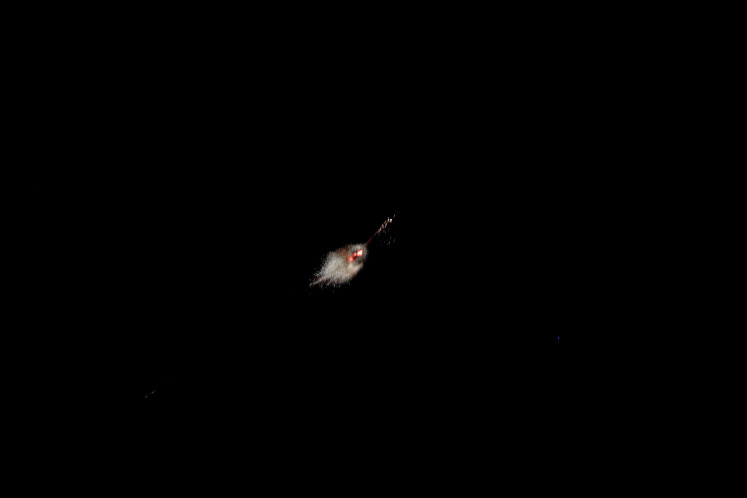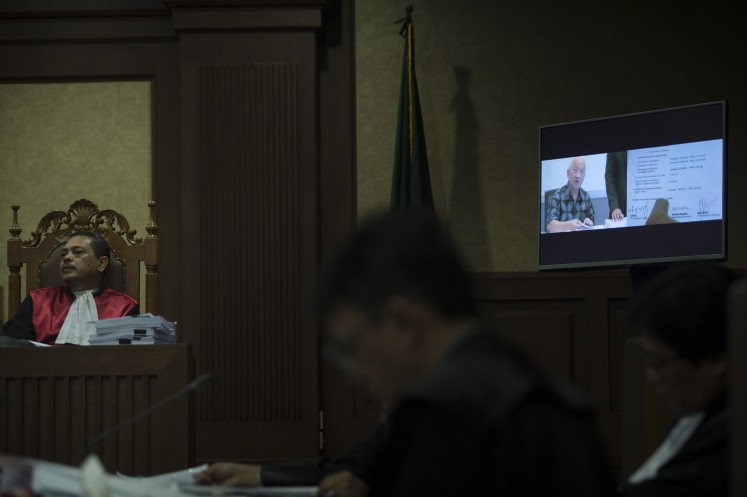Popular Reads
Top Results
Can't find what you're looking for?
View all search resultsPopular Reads
Top Results
Can't find what you're looking for?
View all search resultsEko Supriyanto's 'Cry Jailolo' dazzles in Paris festival
Eko Supriyanto’s novel dance piece Cry Jailolo, the first of a future trilogy, was launched officially in November 2014 at the bi-annual Indonesian Dance Festival in Jakarta. However the European première took place during the Internationales Sommerfestival Kampnagel in Hamburg, Germany last year in August.
Change text size
Gift Premium Articles
to Anyone
 For Cry Jailolo, Supriyanto, lived and worked with 350 men selected from the Sahu tribe in the secluded area around the bay of Jailolo in West Halmahera, North Maluku. (Festival de l'Imaginaire/File)
For Cry Jailolo, Supriyanto, lived and worked with 350 men selected from the Sahu tribe in the secluded area around the bay of Jailolo in West Halmahera, North Maluku. (Festival de l'Imaginaire/File)
E
ko Supriyanto’s novel dance piece Cry Jailolo, the first of a future trilogy, was launched officially in November 2014 at the bi-annual Indonesian Dance Festival in Jakarta. However the European première took place during the Internationales Sommerfestival Kampnagel in Hamburg, Germany last year in August.
After touring last year, the Cry Jalilolo production was invited to perform at Quai Branly Museum, Paris, premiering on Nov. 18 as part of the celebrations marking the 20th anniversary of the Festival de l’Imaginaire.
According to the official presentation of EkosDance company, Cry Jailolo gives form to the potential of remote communities and the collective and individual experience of Indonesia today. The choreographer transforms Indonesian folk dances, such as Legu Salai or Soya Soya, into futuristic dance visions, a re-conceptualization of movement.
Jailolo island was once a sultanate close to others in the spice islands, Ternate, Tidore and Bacan around Halmahera, West Maluku.
Supriyanto, born in 1970, was considered to be the leading Southeast Asian choreographer of his generation, praised Australian producer Jala Adolphus, who was also present in Paris.
Versed in Javanese court dances and pencak silat, a martial art, taught by his grandfather from the age of seven, he performs worldwide and directs his own company, EkosDance, based in Solo, Central Java.
(Read also: Teater Koma's ‘Opera Kecoa’ returns to stage after 13 years)
Eko mixes pop and folk, classical, avant garde, musicals and high culture in productions, such as operas by John Adams, choreography for legendary director Peter Sellars, as advisor for the musical The Lion King or partaking in Madonna’s Drowned World Tour.
For Cry Jailolo, Supriyanto, lived and worked with 350 men selected from the Sahu tribe in the secluded area around the bay of Jailolo in West Halmahera, North Maluku. This is one of the world’s most pristine diving regions, where the unique coral landscape is in danger of being destroyed by mass tourism and over-fishing and destructive fishing using dynamite.
Eko was invited by the regent of the region to promote ecotourism in the area three years ago and was given all the facilities for his fieldwork, including plane tickets to and from Solo. However the regent, himself an excellent diver, told Eko that the only condition was that he should learn to dive. Supriyanto, now a qualified diver, was clearly inspired by the feeling of weightlessness underwater.
(Read also: Culture and art in Kampung Celaket Festival)

Supriyanto explained, “The original Legu Salai dance portrays the meeting between ocean and mountain where the extraordinary energy of individuals comes together with that of the community and environment. It is quite simple, but full of energy, so I exaggerated the tempo and movements. I chose seven among the 350 men -- they are between 17 and 21 years old, and not professional dancers.”
Producer Jala Adolphus added, “In fact for this tour in Paris, two of the dancers had never been outside of Maluku, let alone out of Indonesia. The young men there only travel when they join the military or the police force, the sole professional organizations available.”
The choreographer was equally inspired by the beauty of the coral reef and its mobile swarms of fish, driven by the extraordinary energy of the ocean’s movements, the climatic conditions and the commitment to preserving a traditional way of life as divers or fishermen.
Supriyanto’s transformation of the Legu Salai dance is intended to alert Indonesians and warn the world that the destruction of marine ecosystems is well underway. It is not merely a futuristic vision of dance movement that takes place on a bare stage with extremely sparse lighting by Iskandar Loedin.
(Read also: Tom Ibnur - Believing in Dance)
At times the dancers, clothed in long red shorts, powerfully tap with their feet in accelerated rhythm or sway fluidly in a more contemporary version of the traditional dance. Alternatively, the group chants while they change their roles from fishermen or divers for example, to being part of the seascape or the wind blowing.
Occasionally a single dancer breaks out of the group to perform a solo, accompanied by the six others. Veyndi Dangsa radiated great energy with extraordinary hand and body movements, revealing a strong stage presence in the group of seven dancers. Veyndi was one of the three young men chosen to complete dance training at the Solo Academy of Art.
At the beginning, one solo dancer slowly emerged from the darkness, tapping his left foot for at least five minutes in crescendo, before the other six joined him in the turquoise light.

Suddenly after frenzied dance movements, the seven froze and there was an almost unbearable silence for a pause that stretched into eternity, then the movements slowly commenced.
Afterwards, six dancers, one by one, left the stage and the solo dancer began to tap hypnotically with his foot again, ever more softly until he too, disappeared in the darkness.
The music score, created by Setyawan Jayantoro, a pupil of Supanggah at the academy in Solo, versed in traditional gamelan music as well as being a violinist, bridges ancient Javanese and modern music traditions. Jayantoro incorporated sound effects like the incessant stamping of feet, chants and clapping hands with strains of violin music in his compositions.
Fifty-five minutes spun fast like a vivid and passionate dream.
---------------
Interested to write for thejakartapost.com? We are looking for information and opinions from experts in a variety of fields or others with appropriate writing skills. The content must be original on the following topics: lifestyle ( beauty, fashion, food ), entertainment, science & technology, health, parenting, social media, and sports. Send your piece to community@jakpost.com. Click here for more information.









